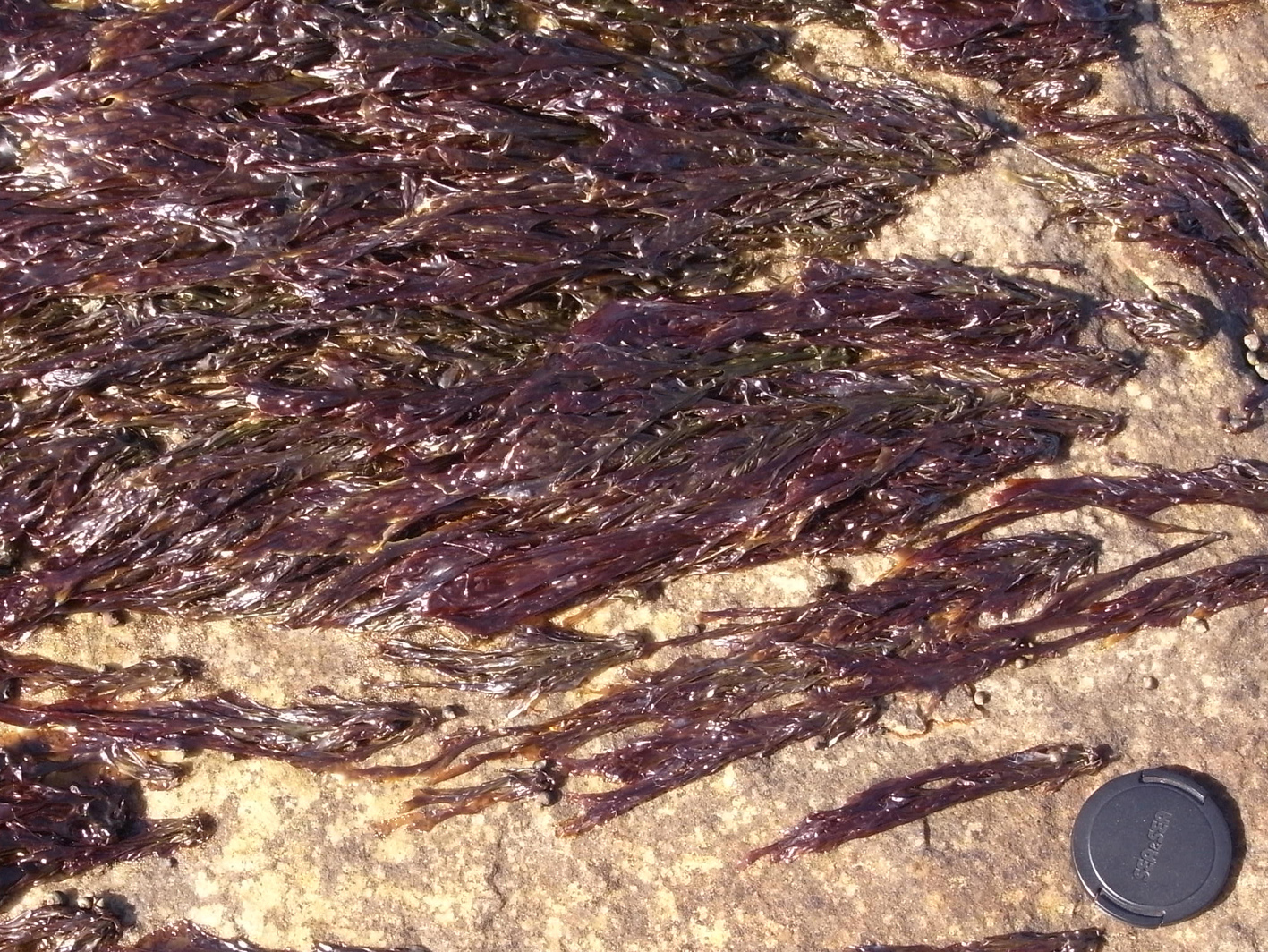Seaweeds of the South African South Coast


Order Bangiales
Family Bangiaceae
Porphyra sp. 1 nov.
Gametophytes comprising deeply laciniate rosette thalli that may appear star-shaped, consisting of multiple lanceolate to orbicular blades with entire margins attached to a central discoid holdfast. Thalli generally small (commonly around 60 mm in diameter) but may reach up to 300 mm in diameter. Fresh specimens light olive green to light pinkish-brown, progressively becoming more green or golden brown when dried and adheres poorly to herbarium paper. Blades monostromatic, 60-65 (-75) µm thick. In cross section of the thallus, vegetative cells 25-40 (-60) µm high, commonly around 30 µm, rectangular to ellipsoid, only slightly longer than wide. In surface view, vegetative and reproductive cells evenly distributed in longitudinal rows with large spaces between neighbouring cells. Spermatia small, lanceolate and bright yellow. Zygotosporangia large, ovate and deep maroon. Female reproductive cells with recognisable bipolar trichogynes. Spermatia arranged in 8 rows, in two columns, in pairs (16-32 tiers). Zygotosporangia arranged in four columns (32-64 tiers). Both spermatia and zygotosporangia observed in fertile plants suggesting a monocieous habit. Spermatia and zygotosporangia are not intermingled as in South African Pyropia species.
Collections, ecology and regional distribution
Recorded from Mossel Bay to the Port Alfred area (27-39). Attached to rock along the mid to high shore, occasionally on the low shore. Gametophytes are present for a few weeks at a time but can be found throughout the year. This species is endemic to the South African coast and was found from Port Alfred to Mossel Bay during the winter but may extend eastwards to Arniston during the austral spring and summer (T.S. Dlaza; unpublished data).
Type locality: Port Elizabeth (MM Reddy, publication in prep.)
Note 1. This species was previously misidentified as a dwarf form of P. capensis (Graves 1969), and is sparsely distributed along the South African south coast. At Plettenberg Bay, it was abundant and thalli were larger, darker and thicker than at other sites. Species belonging to the P. capensis complex and P. sp. 1 nov. have been found to co-occur at this site. Porphyra sp. nov. differs genetically from other species belonging to the P. capensis complex by 4-5% in the cox1 gene, 2-3% in the rbcL gene and 1-2% in the nSSU gene (M Reddy, pers. comm.). This entity was denoted as Porphyra ZPP by Jones et al. (2004).
Note 2: There is a second south coast entity, that emerges as a molecular sister species to Porphyra sp. nov.(MM Reddy, specimens EL1-7, DKG5, pers. comm.). However, the two are morphologically indistinguishable. This sister species has been recorded (at mid-tide level) only from two localities that are about 1000 km apart: East London, and De Kelders. Interestingly, these two localities lie just outside the present distribution range of Porphyra sp. 1 nov.

Porphyra sp nov, Cape St Francis. (Lens cap 50 mm in diameter).

Porphyra sp nov, young thalli, Morgan Bay.

Figures a-k. Porphyra sp. nov. Morphological and anatomical characters. a-c, h) Overall thallus morphology, d-e) Surface view showing vegetative cells, f) Surface view showing reproductive cells, g) Cross section of thallus showing vegetative cells, i) Cross section of thallus showing immature and developing reproductive cells, j) Zygotosporania in cross section and k) Spermatangia in cross section. Illustrations by M.M Reddy.
References Porphyra sp. nov.
Graves, J.M. 1969. The genus Porphyra on South African coasts: 1. Observations on the autecology of Porphyra capensis sensu Isaac (1957), including a description of dwarf plants. Journal of South African Botany 35: 343-362, 4 figs, 4 plates.
Jones, W.A., Griffin, N.J., Nelson, W.T, Farr, T.J. & Broom, J.E. 2004. Phylogenetic diversity in South African Porphyra (Bangiales, Rhodophyta) determined by nuclear SSU sequence analyses. European Journal of Phycology 39: 197-211.
Reddy, M.M., De Clerck, O., Anderson, R.J., Leliaert, F. & Bolton, J.J. 2018. A rosette by any other name: Species diversity in the Bangiales (Rhodophyta) along the South African coast. European Journal of Phycology, https://doi.org/10.1080/09670262.2017.1376256.
Cite this record as:
Anderson RJ, Stegenga H, Bolton JJ. 2016. Seaweeds of the South African South Coast.
World Wide Web electronic publication, University of Cape Town, http://southafrseaweeds.uct.ac.za; Accessed on 07 January 2026.